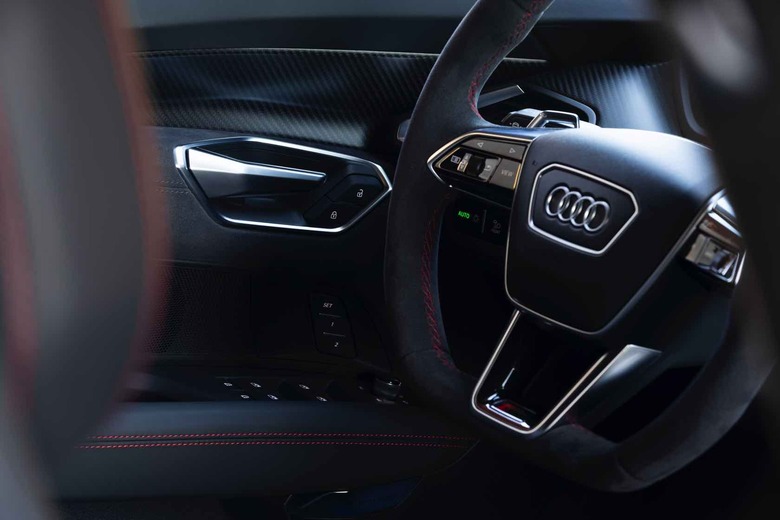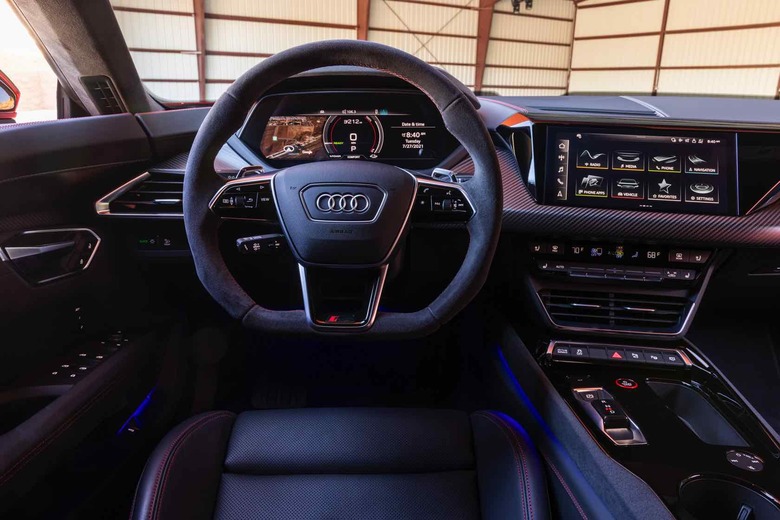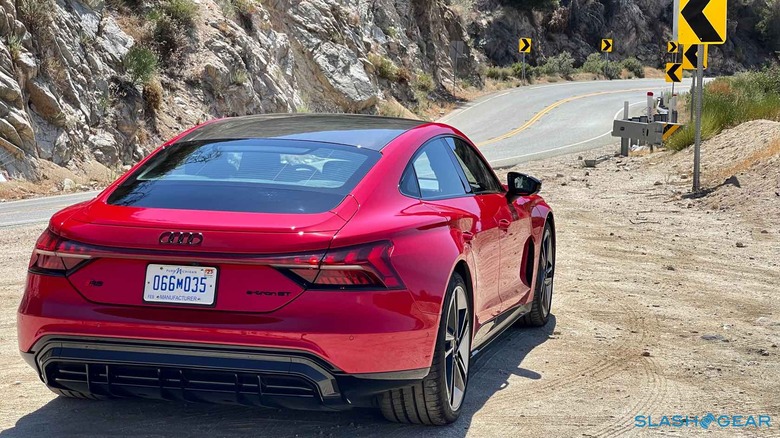2022 Audi RS e-tron GT Review
- Sleek and seductive GT styling
- Comfortable long-distance cruiser
- Legitimately fast in regular and RS form
- Speedy DC fast charging
- Range falls short of rivals
- Cabin lacks the drama of the original GT concept
It seems a long time since I was lucky enough to get a first crack of the Audi e-tron GT about three years ago. At that point the sleek four-door EV was still a prototype, though even then its focus was fairly clear. While Audi's high-performance electric grand tourer may be the mechanical twin of the Porsche Taycan, here that all drives to a different tune. Porsche touts the Taycan as a four-door all-electric sportscar, as close right now to a four-seater electric 911 that you can get. Audi's e-tron GT, meanwhile, is a genuine grand tourer, albeit one with the same propensity for speed as the Taycan.
Unlike with Porsche's range, there'ss no single motor, rear-wheel-drive option on the Audi e-tron GT. Instead you can get an RS version that delivers more power. The Audi e-tron GT has two permanently excited synchronous (PSM) motors, one in each axle: the standard Quattro version delivers up to 522 hp with 464 lb-ft of torque, good for 0 to 60 mph in 3.9 seconds and on to a top speed of 152 mph. It's more than enough electric ponies for most owners looking for something equally at home with the daily commute or shuttling the kids to school, but still with some potential for fun.

Those special buyers who demand more, meanwhile, should consider the e-tron GT that sports the RS badge. The 2022 Audi RS e-tron GT is the fastest and most potent RS car to date, although it's not quick enough to take on the Porsche Taycan or Tesla Model S Plain in an impromptu drag race. Powered by the same two electric motors as in the non-RS car, here you can expect up to 637 hp in over-boost mode, enough to breach 60 mph from a standstill in 3.1 seconds. It also has a higher, 155 mph top speed than the regular Quattro version.

Going fast in a straight line is decidedly easy. The RS e-tron GT consistently struck the 2.97 to 3.2 second range during our repeated back-to-back launch control tests, on a hot airstrip after numerous slalom runs. My personal best time was 3.09 seconds at a top speed of 124 mph. It's honestly incredible how straightforward it was to set up launch control: disengage the traction control, switch to Dynamic drive mode, step on the brake pedal, smash the accelerator, and then release the brake when the tach hits 100%.
Admittingly, the sensory experience is nowhere as surreal as in, say, Audi's R8 V10 Plus: without the screaming gas engine soundtrack it's easy to feel a little underwhelmed, particularly if you're a sports car traditionalist. All the same, the lift-off makes up for the difference. It's deadly fast and near-silent; you don't quite realize just how fast you're going as your body is pressed against the 18-way RS Sport Seat+ with their handsome full-leather trim.
The two-speed gearbox mated with the electric motors feel relentless, propelling the e-tron GT with the tenacity of a land-bound rocketship. Personally, the steering felt a little lighter than I'd prefer when pushing the RS e-tron through the slalom. Out in the real world, though, slicing through the curvaceous mountainside, it managed to offer the delicate precision of an R8.
Overall, the performance feels nimble, agile, planted, and ready to obey your whims with almost minimal body roll. The flat-bottom steering wheel adds a nice sporty touch, too. Honestly, I found this surprising as the steering and pedal feel made it seem the e-tron GT is lighter than its sub-5,200 pound curb weight. There's no other way of saying it: the Audi e-tron GT drives as nice as it looks.

Powering the electric motors is a 93 kWh lithium-ion battery pack with an 800-volt electrical architecture, and capable of accepting up to 270 kW of DC fast charging. Depending on your driving needs, you get 238 miles on the e-tron GT and six less on the RS version from a full charge. If longer range is essential, I'd be remiss if I didn't steer you toward the 2022 Mercedes-Benz EQS and Tesla Model S, which each offer somewhere between 400 and 500 miles of range.
The Audi e-tron GT and RS e-tron GT are more about grand-touring performance and luxury, rather than outright acceleration. For reference, Audi's car is marginally longer than a Taycan yet slightly narrower and taller, despite both electric cars sharing the same J1 platform. Where the e-tron GT truly shines is in the styling department, thanks to Audi's head of design, Marc Litche. His vision for quattro in form and function brings the muscular wheel arches to life, giving the e-tron GT a solid and planted stance. At the same time, the short overhangs and gorgeous proportions are worth writing home about.

My year one Tango Red metallic RS e-tron GT tester packed all the performance features, black Audi rings, and badges expected of an RS model. The three-chamber air suspension system is Godsend on extended drives, helping offset any of the firmness bumps that the sizable 21" 5-twin-spoke-concave wheels might otherwise present you with. You also get an electronic rear differential with a multi-plate clutch, carbon-ceramic brakes with red calipers, and power steering plus with rear-wheel steering. The latter is a similar version to that found in the magnificent Audi RS6 Avant and RS7 Sportback, capable of tilting the rear wheels in either the same or opposite direction as those at the front to improve high-speed stability and low-speed maneuverability.
The air suspension really is fairly magical. I didn't find the ride quality between the 20" wheels on the e-tron GT to be that much more different than the RS' standard 21" wheels. Despite the ultra-low profile rubber, Audi manages to deliver a supple, cosseting ride.

When playtime is over, the drive back to the hotel gave the Audi e-tron GT an opportunity to demonstrate its ability to pamper as well as perform. The interior is immaculate, no surprise given that's one of Audi's perennial strengths. The RS version is a triumph of leather, real metal, and Alcantara, although leather-free Dinamica upholstery is also available. It gets a 12.3-inch digital instrument cluster and a 10.1-inch MMI infotainment touchscreen.
The cabin feels roomy enough to accommodate four adult passengers, but the molded seatbacks could be a problem for rear passengers with longer legs: anybody above 6 feet 2 inches may want to call shotgun. Three passengers can fit in a pinch, but the heavily bolstered rear seats in my RS e-tron GT test car isn't going to make that a particularly happy situation on a longer trip. If it's any consolation, the rear seats can fold down should you need to carry longer items in the trunk, with up to 14.3 cu-ft of cargo space making the e-tron GT weirdly practical. As a plus, the front trunk (or frunk) has 2.9 cu-ft of additional storage space, roomy enough for a small to medium-sized overnight bag.

Perhaps the biggest triumph in the interior is the ergonomics. The e-tron GT concept I drove in Los Angeles a couple of years back had a two-tier center console with two touchscreens, similar to what you'll find in other Audi RS models like the RS7 Sportback and RS6 Avant. Instead of having a smaller screen below the center touchscreen, though, the e-tron GT has conventional buttons for the drive modes, heated seats, and HVAC system.
In place of a traditional shift knob, the e-tron GT has a sliding switch that you push up or down to cycle between Reverse, Neutral, and Drive. There is no P or Park mode, but the vehicle automatically engages Park if it's not moving or if you open the door while stationary. Above and to the right of the center console cupholders is a nifty circular button for the audio system: you can turn on the audio, skip a track, or mute the volume with that one control. Sliding your finger around the edge of the switch, meanwhile, increases or decreases the volume. It's a slick way of offering plenty of features without forcing you to take your eyes off the road.

All the same, despite those little flourishes, what stands out is how close the interior of the e-tron GT feels to Audi's existing models such as the aforementioned RS7 Sportback. Audi has prior form there, of course: its original 2019 e-tron SUV intentionally stuck to the same recipe as its gas SUVs, in an attempt to make the transition from combustion to electron as seamless and unchallenging as possible to brand loyalists. While I can see the appeal of such a strategy, I can't help but wonder if there was a little more room for pushing the envelope in the e-tron GT's cabin, especially given the more striking exterior.
What Audi gas cars don't have, though, is the 'e-tron sound' system, which comes standard in the RS model. It utilizes four speakers – two inside, two outside – along with a control unit and amplifiers hidden under the trunk. It monitors your speed and throttle inputs to play a futuristic sound as you bury the pedal, and also plays a pulsating sound from the outside to warn bicyclists and other pedestrians at low speeds. I suspect whether you like it or not will be a matter of taste; if you fall into the latter camp you'll be gratified to discover that, aside from the pedestrian safety part, you can shut most of the sounds off.

As tested, the 2022 e-tron GT came in at $109,195: that included the $6,000 performance package, $2,250 for the driver assistance package, and $1,045 for the destination charge. Stepping up to the year one package RS e-tron GT dramatically increases the price to $161,890 all-in. Granted, the MSRP is $139,900: the $20,350 year one package simplifies the buying process by adding in all the goodies in one fell swoop, leaving the only extra the $595 Tango Red Metallic paint and matching the grille to the body color for another $350.
2022 Audi RS e-tron GT Verdict
The Audi e-tron GT and RS e-tron GT are some of the finest and most beautiful electric cars launched to date. Both will spoil you with Audi-levels of build quality and refinement, while still offering otherworldly performance. The range may be an issue for some, but the overall package is hard to ignore if you have six figures to spend on an all-electric grand-touring performance car.

